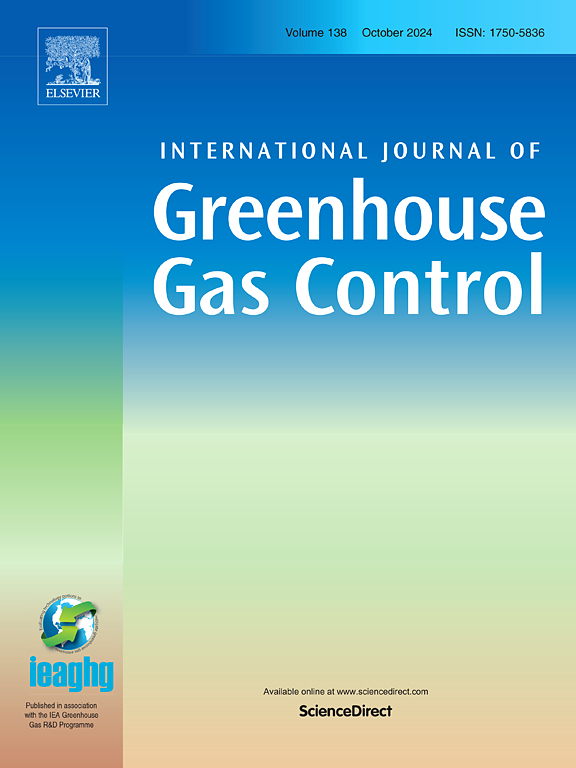低含水饱和度下二氧化碳-水相对渗透率的不确定性的实验室和文献见解
IF 5.2
3区 工程技术
Q2 ENERGY & FUELS
International Journal of Greenhouse Gas Control
Pub Date : 2025-10-01
DOI:10.1016/j.ijggc.2025.104482
引用次数: 0
摘要
确定co2 -水排水相对渗透率通常需要实验室实验,然后进行数值历史拟合。然而,在实验室中实现低水饱和度是具有挑战性的。因此,这些低饱和度的相对渗透率值——尽管对现场尺度建模至关重要——必须外推,这带来了很大的不确定性。以前的研究使用连续的数学函数(如Corey或let)来定义整个饱和度范围内的相对渗透率曲线。在这些函数中,曲线参数的变化影响高饱和度和低饱和度值,掩盖了低饱和度下存在的特定不确定性。在这项研究中,我们重新分析了已发表的数据,揭示了低含水饱和度下广泛的似是而非的相对渗透率值,所有这些数据都产生了同样好的历史匹配,这表明该地区存在大量隐藏的不确定性。为了缓解这一问题,我们进行了实验室实验,将饱和水CO 2注入到78孔隙体积(PV),达到34%的含水饱和度,远低于通常报道的水平。随后,在恒压下使用多孔板进行脱饱和,进一步将水饱和度降低到0.225,从而可以直接测量最大CO₂相对渗透率。结果表明,扩大CO2注入可以降低低饱和度下相对渗透率的不确定性,但实验限制在0.34含水饱和度以下。包括多孔板数据显著提高可靠性通过应用较高的毛细管压力代表现场条件。这项工作强调了先进的实验设计的必要性,以扩大CO₂-水相对渗透率测量的可靠性,以降低水的饱和度。这些发现对于提高野外尺度二氧化碳封存模型的预测精度至关重要。本文章由计算机程序翻译,如有差异,请以英文原文为准。
Laboratory and literature insights into uncertainty in CO2-water relative permeability at low water saturations
Determining CO2-water drainage relative permeability generally requires laboratory experiments, followed by numerical history matching. However, achieving low water saturations in the laboratory is challenging. Consequently, the relative permeability values at these low saturations—though essential for field-scale modelling—must be extrapolated, introducing significant uncertainty.
Previous studies used continuous mathematical functions—such as Corey or LET—to define relative permeability curves across the full saturation range. In such functions, changes to curve parameters affected both high and low saturation values, masking the specific uncertainty present at low saturations. In this study, we reanalyzed published data revealing a wide range of plausible relative permeability values at low water saturation, all of which yield equally good history matches—indicating substantial hidden uncertainty in this region.
To mitigate this, we performed laboratory experiments with extended injection of water-saturated CO₂ to 78 pore volumes (PV), achieving 34 % water saturations, much lower than commonly reported. Following this, desaturation was performed at constant pressure using a porous plate to further reduce water saturation to 0.225, enabling direct measurement of maximum CO₂ relative permeability. Results indicate that extending CO2 injection reduces uncertainty in relative permeability at lower saturations, though experimental limitations persist below 0.34 water saturation. Including porous plate data significantly improves reliability by applying higher capillary pressures representative of field conditions.
This work highlights the necessity of advanced experimental designs to extend the reliability of CO₂-water relative permeability measurements to lower water saturations. These findings are crucial for enhancing predictive accuracy in field-scale CO₂ sequestration modelling.
求助全文
通过发布文献求助,成功后即可免费获取论文全文。
去求助
来源期刊
CiteScore
9.20
自引率
10.30%
发文量
199
审稿时长
4.8 months
期刊介绍:
The International Journal of Greenhouse Gas Control is a peer reviewed journal focusing on scientific and engineering developments in greenhouse gas control through capture and storage at large stationary emitters in the power sector and in other major resource, manufacturing and production industries. The Journal covers all greenhouse gas emissions within the power and industrial sectors, and comprises both technical and non-technical related literature in one volume. Original research, review and comments papers are included.

 求助内容:
求助内容: 应助结果提醒方式:
应助结果提醒方式:


